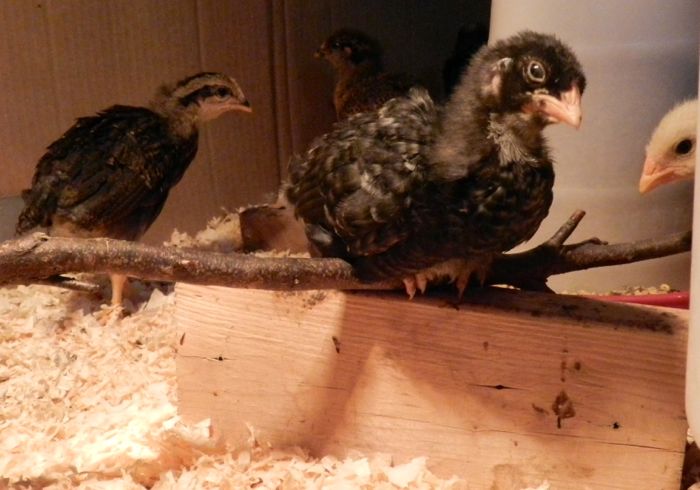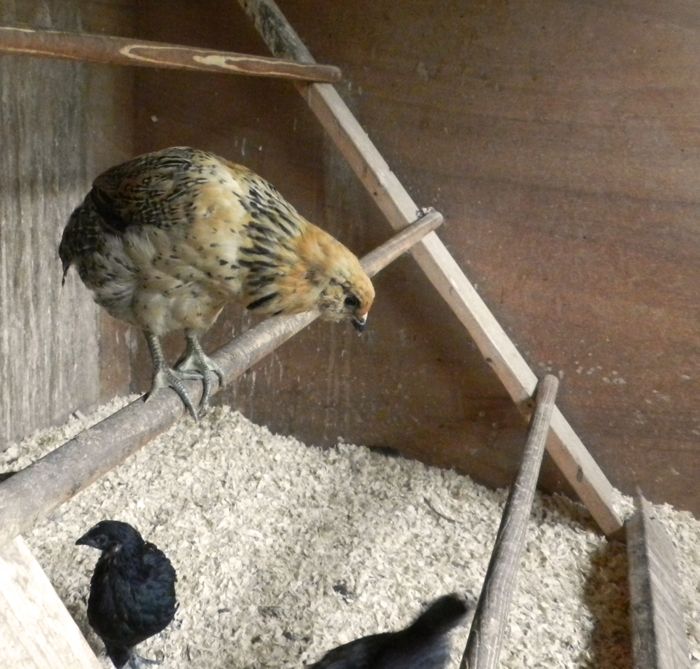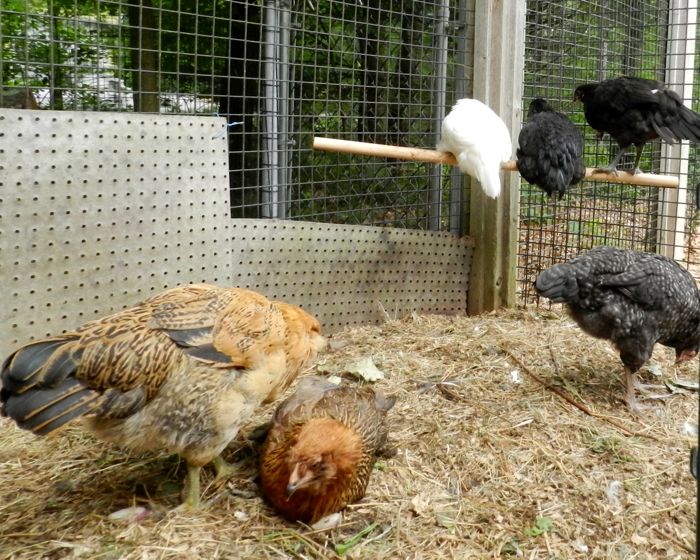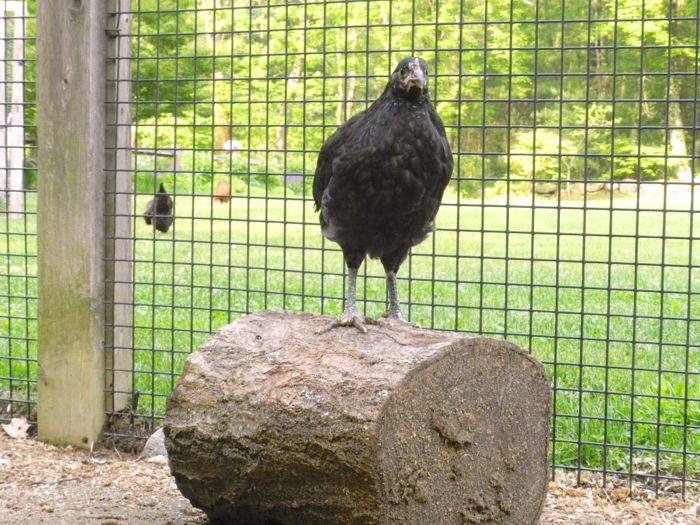From the comments, both in private emails and on the last post, it was clear to me that more needs to be said about roosting behavior for young chickens. Why won’t your pullets go into the coop at night, get up on the roosts to sleep like they’re supposed to?
Chickens naturally want to roost (unless they’re Silkies or heavy meat hybrids). Encourage this when they are very young. Here my 3 week old chicks are getting up on their “training roosts” and learning to balance and nap off of the ground.
Give the chicks a chance to explore the coop without old hens there to hassle them.
Once the chicks venture outside, you should provide roosts for them in their pen.
Although, they’ll also find other things to get up onto.
Given the opportunity, your pullets will find places to roost, whether designed for them, or not.
By the time they are feathered out and no longer need a heat lamp, they’ll want to roost at bedtime, too. If not, read yesterday’s post. Add to that list mites – these blood-sucking minuscule parasites live in the woodwork during the day, but come out at night. When the infestation is bad you’ll see them crawling on the roosts and on your birds. They can make your chickens’ lives miserable. I haven’t experienced it here, so I don’t have a FAQ for you, but I can tell you that you’ll have to thoroughly disinfect the coop, use chemicals on your birds, paint to seal the wood, and possibly redesign the coop to rid it of these pests.
But, I think that for most of you, if your pullets are showing normal roosting behavior outside of the coop, and yet you’re still not seeing them roost at night, you either have badly designed housing, or your older hens are intimidating the young ones, or there’s a combination of the two.
As mentioned yesterday, the coop should be inviting. It should have cool, fresh air, windows for light, and enough space to generously accommodate your flock. Space is often the key. Old hens do not want the youngsters on their turf. They don’t want to sleep next to them. They will not play “nice.” Expect that and design for it. Have roosts at different levels. Have more than 6 inches of bar space per bird. Have enough floor space so that the pullets can avoid the domineering hens by scooting around them. If a hen can block all access to the coop, or pin a pullet in a corner, then the coop is too small for your flock. If you have one truly mean hen (think Edwina when she was young) then remove her for a few days to give the youngsters time to become confident in their new surroundings.
If you don’t have old hens scaring the pullets, and they still aren’t roosting, you might be rushing things. They don’t start roosting until they no longer need the heat lamp. They don’t all start roosting at night until about six weeks of age. By ten weeks they should be up on the poles. The few laggard can lifted up and set next to the rest of the flock, and they’ll catch on quickly to the routine.
Chickens might seem dim-witted, but they do what they do for their own good reasons. It’s your job to figure out what those reasons are. It’s not complicated, but you do have to see the world from a chicken’s perspective.






I love the last picture. :) My pullets have a roost in the run and they use it….but my RIR and Jersey Giant like to squeeze into the little space of their pop door and roost there.
I had a horrible infestation of mites last year, if you went to collect eggs in just a split second you would have tons of them on you, what i did was bought some manapro poultry protector and DE… I douced the girls in the poultry protector and gave the house a thorough cleaning spraying everything down with the poultry protector and then putting DE all over the floor and rubbing in on the walls of the coop…it minimized the problem, and then with the freeze of wonter it eliminated the problem all together and I have not seen one this year… I can not Stress the importance of a DE dust bath for the birds in my opinion it is thied to food and water
Sorry for that little rant Terry…
If I had mites in the coop, I’d be ranting, too. Mites are NOT lice. Anyone interested should read my FAQ about lice. Also, always remember that the DE to use is FOOD GRADE. Regular DE (the garden variety used for slug, etc. control) can kill your birds.
re jpnathan’s two comments above. i say there’s nothing wrong with a good rant now and then. you should have heard me when a stray dog came into my yard and beat up on my properly, humanely tied-out pet dog. and then on the way to get him another collar, i got stopped by a policeman for speeding (5 miles over the limit) not having a seat-belt on. and a window tinted too dark. and if the other dog had been securely fastened, the whole scene wouldn’t have happened anyway. i ranted.
the policeman was a gentleman, he gave me every exception he could and didn’t even fine me for ranting.
that’s how i know it’s o.k.!
Beatrix is out and shining in all her glory. She gets more beautiful each day. I did as you said Terry, and just waited to see if the girls would go into coop last nite. They did without any problems. They still went to that corner and piled up. I have roost, like yours in the Little Barn, but they seem to just like to play on them in the day. We had a roost in their brooder. Two rungs, highest at about 12 inches off floor. They were all roosting at nite by the time they were ready to go into coop. Tonite will be their fourth nite. Doc said they may be a little scared since it’s a new place. The waterer is in that corner and they pile up under it. They roosted once so I feel confindent they’ll roost again. The coop was dusted with DE before they went in it, but I didn’t dust the roost. I’ll be doing that today. Things seem a lot better today. Thanks for your help.
Speaking of roosting on spots not designed for roosting:
1. Roosting on top of the two box fans hung in the windows.
2. Young OEG bantams roosting on the inside eaves between the roof and wall.
3. I’ve seen a young pullet trying to balance on the extension cord that ran from the outlet to the fan. I fixed that issue immediately.
4. In my old coop I kept the feed cans in the coop and at least one hen always found that to be the perfect spot. MESSY!!!
Ken, I’ve taken to putting pie pans on surfaces that I don’t want the chickens – a nice scary rattly experience when they try to balance on them :)
Just noticed Phoebe the Squatter! … Where does dear old Buffy go now? Has she got a new place to hide away?
Buffy angrily tells Phoebe off, but Phoebe, in true rabbit style, ignores her.
I have an on going battle with one of my girls roosting where she should not.
I will win…probably…maybe… :) x
Terry, my pullets (17 weeks) are using the roost in thier run; but, not so much in the coop. I see very, very little poo under them. And some thing else, I have noticed the pullets eating the small feathers from others preening. What’s up with that?
Feather eating can become a bad habit. Make sure you chickens have poultry grit. Also, at 17 wks they’re close to lay and might be looking for minerals. Give them oyster shell free choice.
Terry could not be more right on this one. Need to discourage this habit as soon as possible.
Sometimes it is boredom that will cause this. My hens must be confined to their run so to help with boredom I always have bale or two of straw on hand. I throw a flake or two around the run, throw a little scratch grain in and it keeps them busy most of the day scratching it from one end of the run to the other.
Scratching all day long couldn’t be more natural for a chicken.
Great suggestion, Ken. The compost pile that I have in my run keep my chooks busy.
Talk about squatters…look at that Misty taking over Buffy’s thinking log! Young whippersnapper.
sHOULD i OPEN THE NOW BLOCKED NESTING BOXES NOW? oR WAIT ANOTHER WEEK OR SO. OOPS CAPS ON SORRY. IHAVE HAD OYSTER SHELL AND GRITT AVAILABLE. THEY DON’T SEEM TO WANT IT. THANK YOU SO MUCH!
If they are roosting in the proper place at night, you can open up the nesting boxes. Even if it looks like they’re not eating the grit or oyster shell, make sure it’s available (see my feeding FAQ for dispenser suggestions.) Give them a hard squash or a watermelon to peck to keep them busy.
One or more of my pullets have diarrhia. I read in a mag. to give them vinager in thier water. That it could be caused from stress. Do you know how long it will take to work?
Is there any kind of preventive maintenance against mites?
Nicolo, the food grade diatamaceous Earth mixed with play sand, so they can take dust bathes… if the birds stay mites free the cicken house will have minimal to no mite…. also keep the hens food in the hen hous to keep wild birds away..
Thank you! :)
I have the meanest hen. She does not quit harassing the young hens. She is the rooster in the flock and does all the things roosters do (ahem) and still lays the eggs. Sometimes during the evening free-ranging I am able to isolate her, and all becomes so peaceful. I guess I’ll have to catch and remove her for a while.
I would give her a few days time-out.
OK, my afternoon was setting up her time out pen. I bought a 24″ high play pen, like for small dogs, at TSC, and shaped it into a square so my netting would fit on top. I put in a dog carrier with hay for her nest box, food, and water. She is not happy, but the henhouse is so peaceful. :) I should have done this long ago…then I captured a bee swarm. It’s been a busy day!
I had an outbreak of mites a couple of years ago. It was awful and if you reached in the nest box your arm looked like it was covered in pepper! I treated similar to Jonathan but with neem oil and food grade diatamaceous earth. I filled a spray bottle with warm water a drop of dish soap and tablespoon of pure neem oil and you shake it up to emulsify it. I got the neem oil at a gardening store. Then I cleaned the entire coop out and sprayed every surface with the neem spray, really coating the roosts and all the cracks. I let it dry and then took a fluffy dry paint brush (it works really well with the DE) and dusted every surface with the diatamaceous earth. I added the shaving back and mixed some DE in with those as well. I dusted the birds with some DE also. The neem oil is natural and non toxic when diluted in water. I sprayed it on my hands and rubbed it through their feathers. Over the next 2 weeks I sprayed the roosts a couple more times with the neem oil spray and the mites have never come back, thankfully!
Thanks for sharing this, Jenny. Good to know that what you did worked.
Jenny I am definatley going to do the neem oil for good measure
I am very glad to know about it too.